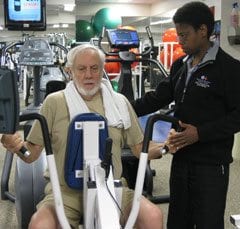
For 11 years, exercise physiologist Marlene DaCosta has been creating exercise regimes for people with arthritis and many other health issues at Beth Israel’s Tanger Be Well Center. She knows what it’s like for them. She has osteoarthritis in her right hip and has had lupus for 18 years — and she exercises most days of the week to control her conditions.
One of her clients is Warner Slack, M.D., a 75-year-old professor of medicine at Harvard Medical School. An old football injury caused osteoarthritis in his knee, eventually resulting in surgery. He was determined to get his knee and body back in shape before any more damage was done.
“Problems like osteoarthritis in your knee can lead to a whole cascade of problems, like back pain or even injuring your other knee, because you tend to get out of balance,” said DaCosta.
DaCosta, who holds a master’s degree in exercise physiology, started Slack on a gentle exercise routine to strengthen his knee and keep the rest of his muscles strong. Mindful that exercise can sometimes be overdone, she paced his exercises so that he would work on his upper body one day and his lower body the next.
“No two exercise programs are alike, because every person who comes here has different needs,” said DaCosta. “Every exercise program does have some common elements because absolutely everyone needs some strength training, cardio and flexibility. It’s the combination of these that differs for each person.”
DaCosta, a volunteer and frequent speaker for the Arthritis Foundation, wholeheartedly endorses “Physical Activity: The Arthritis Pain Reliever,” a public awareness campaign created by the foundation and the U.S. Centers for Disease Control and Prevention.
“I totally agree with their message that any type of physical activity helps keep joints limber and reduces pain, including dancing, gardening and even washing the car,” said DaCosta.
It’s important for people to keep moving for at least 150 minutes a week, or 30 to 60 minutes total each day, three to five times per week.
“People with arthritis can easily exercise at home, as long as they keep in mind some important principles,” she said.
First, they need to warm up their bodies, which is essential for getting blood flow to the muscles to decrease the risk of injury. This can be a 5 to 10 minute low-intensity exercise, like walking or riding a bike, until they crack a slight sweat.
Next, they can add other components, such as a cardio routine or strength training. Because stiffness can be an issue, she recommends gentle stretching between exercises and also at the end of exercising.
Some simple exercises for people with arthritis include:
- Stretching before getting out of bed, including movement exercises such as ankle pumps and ankle circles. This will help get blood flowing to the feet and calf areas to reduce stiffness;
- Practicing “sit to stand” — sitting in a chair and using your legs to lift yourself out of the chair;
- Working on upper-body strength by doing push-ups against a wall in a standing position and using soup cans to do arm curls; and
- Strengthening calf muscles by doing heel raises, standing if possible, or seated.
DaCosta also has some tips for reducing morning stiffness.
“Take a shower when you get out of bed and do shoulder rolls in the warm water,” she said. “Wringing a warm, wet washcloth can help loosen fingers.”
DaCosta practices what she teaches to control her own arthritis.
“If I have pain in a particular joint, I work around it, being careful not to stress the inflamed joint,” she said.
She controls her lupus well by getting plenty of rest and eating lots of fruits and vegetables. But, she said, “The most important thing to me is to make sure I exercise regularly.”
“When I move, I feel looser, much less stressed and frankly, much, much better,” she added.
For a brochure on physical activity or other information on arthritis, call the Arthritis Foundation Massachusetts Chapter at 800-766-9449 or e-mail info.ma@arthritis.org.


![Banner [Virtual] Art Gallery](https://baystatebanner.com/wp-content/uploads/2024/04/Cagen-Luse_Men-at-store-e1713991226112-150x150.jpg)



